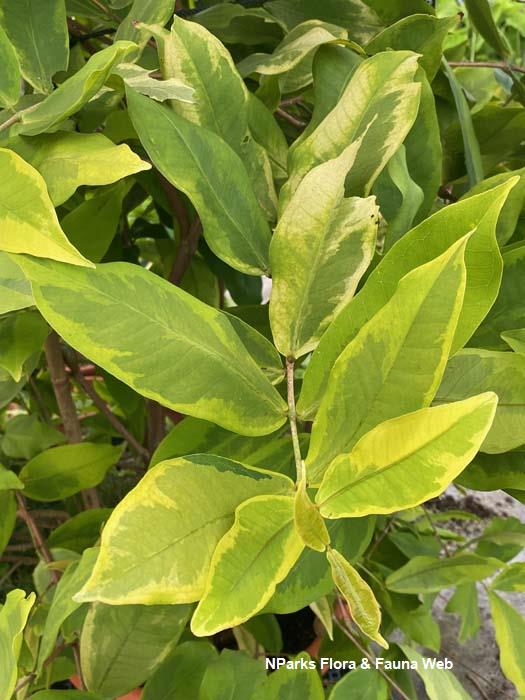
Back
Syzygium syzygioides (Miq.) Merr. & L.M. Perry
| Family Name: | Myrtaceae |
| Synonyms: | Eugenia pseudosyzygioides M.R. Hend., Eugenia syzygioides (Miq.) M.R. Hend., Syzygium caudatum Wall., Syzygium nelitricarpum Teijsm. & Binn. |
| Common Name: | Kelat Hitam |
Name
Classifications and Characteristics
| Plant Division | Angiosperms (Flowering Seed Plants) (Dicotyledon) |
|---|---|
| Plant Growth Form | Tree |
| Lifespan (in Singapore) | Perennial |
| Mode of Nutrition | Autotrophic |
| Plant Shape | Broad / Mushroom / Hemispherical |
| Maximum Height | 30 m |
Biogeography
| Native Distribution | From Northeastern India, through Thailand and Vietnam, Singapore to Indonesia |
|---|---|
| Native Habitat | Terrestrial (Primary Rainforest, Secondary Rainforest, Coastal Forest) |
| Preferred Climate Zone | Tropical |
| Local Conservation Status | Native to Singapore (Least Concern (LC)) |
Description and Ethnobotany
| Growth Form | It is a tree that can grow up to 30 m tall, with a hemispherical crown, and dark greyish to reddish-brown bark. |
|---|---|
| Foliage | Its opposite, stalked leaves have thinly leathery leaf blades that are lance-shaped to oval, and 4–10 by 1.5–5.5 cm. Each leaf has a long pointed leaf tip, 1 vein running parallel to the leaf margin, and many close together side veins. |
| Flowers | Its bisexual flowers are white, about 1.3 cm, and found in up to 7.5 cm-long, few-flowered clusters located at ends of its branches, or axils of its leaves. |
| Fruit | Its fleshy fruits are round to flattened round, 0.8–1.2 cm across, and dark red to purplish-black when ripe. Each seed is oblong to round. |
| Habitat | It grows in lowland forests, which includes secondary forests, and also near rocky and sandy shores. It occurs locally in Changi. |
| Associated Fauna | Its flowers are pollinated by insects. Its fruits are eaten by birds. |
| Cultivation | It can be propagated by seed. |
| Etymology | Greek syzygos, joined, referring to the paired leaves of this species; Latin syzygioides, Syzygium-like, referring to the plant. |
| Ethnobotanical Uses | Cultural / Religious: Heritage Tree : There is currently one individual of Syzygium syzygioides listed as a Heritage Tree in Singapore. It can be found at Changi. To find out more about these trees, please visit the Heritage Tree Register. |
Landscaping Features
| Landscaping | It is suitable to be planted at roadsides, and coastal areas, as it can tolerate hot, sunny, high wind, and frequent salt spray conditions. Its flowers produce nectars that can attract wildlife, like butterflies. |
|---|---|
| Desirable Plant Features | Ornamental Form |
| Landscape Uses | General, Suitable for Roadsides, Parks & Gardens, Small Gardens, Coastal |
Fauna, Pollination and Dispersal
| Fauna Pollination Dispersal Associated Fauna | Bird-Attracting, Butterfly-Attracting |
|---|---|
| Pollination Method(s) | Biotic (Fauna) |
| Seed or Spore Dispersal | Biotic (Fauna) |
Plant Care and Propagation
| Light Preference | Full Sun |
|---|---|
| Water Preference | Moderate Water |
| Plant Growth Rate | Moderate |
| Rootzone Tolerance | Moist Soils, Well-Drained Soils, Saline Soils / Salt Spray |
| Maintenance Requirements | Moderate |
| Propagation Method | Seed |
Foliar
| Foliage Retention | Evergreen |
|---|---|
| Mature Foliage Colour(s) | Green |
| Mature Foliage Texture(s) | Leathery, Thin |
| Prominent Young Flush Colour(s) | Red |
| Foliar Type | Simple / Unifoliate |
| Foliar Arrangement Along Stem | Opposite |
| Foliar Attachment to Stem | Petiolate |
| Foliar Shape(s) | Non-Palm Foliage (Oval, Lanceolate) |
| Foliar Venation | Pinnate / Net |
| Foliar Margin | Entire |
Floral (Angiosperm)
| Flower & Plant Sexuality | Bisexual Flowers |
| Flower Colour(s) | Cream / Off-White, White |
|---|---|
| Flower Grouping | Cluster / Inflorescence |
| Flower Location | Axillary, Terminal |
Fruit, Seed and Spore
| Mature Fruit Colour(s) | Purple, Red |
|---|---|
| Fruit Classification | Simple Fruit |
| Fruit Type | Fleshy Fruit , Non-Accessory Fruit |
Image Repository
Others
| Master ID | 1978 |
|---|---|
| Species ID | 3270 |
| Flora Disclaimer | The information in this website has been compiled from reliable sources, such as reference works on medicinal plants. It is not a substitute for medical advice or treatment and NParks does not purport to provide any medical advice. Readers should always consult his/her physician before using or consuming a plant for medicinal purposes. |







